Abstract
A phenolic glycolipid was obtained in high amounts (2% of dry weight) from Mycobacterium leprae isolated from infected armadillo liver. Infrared and nuclear magnetic resonance spectroscopy showed that it is closely related to "mycoside A" from Mycobacterium kansasii and is therefore a glycosylphenolic phthiocerol diester. The crucial difference between the two products is in the composition of the attached trisaccharide. Gas-liquid chromatography-mass spectroscopy showed that the product from M. kansasii is composed of 2,4-di-O-methylrhamnose, 2-O-methylrhamnose, and 2-O-methylfucose, whereas that from M. leprae contains 2,3-di-O-methylrhamnose, 3-O-methylrhamnose, and 3,6-di-O-methylglucose. The distinct composition of the oligosaccharide segment of the glycolipid from M. leprae may make it useful for the chemical and serological differentiation of this organism from other mycobacteria. Surprisingly large quantities (2.2 mg/g of dry liver) of the glycolipid were also found in infected liver residue freed of M. leprae, suggesting that it may be responsible for the electron-transparent "foam" surrounding the organism in infected lepromatous tissue.
Full text
PDF

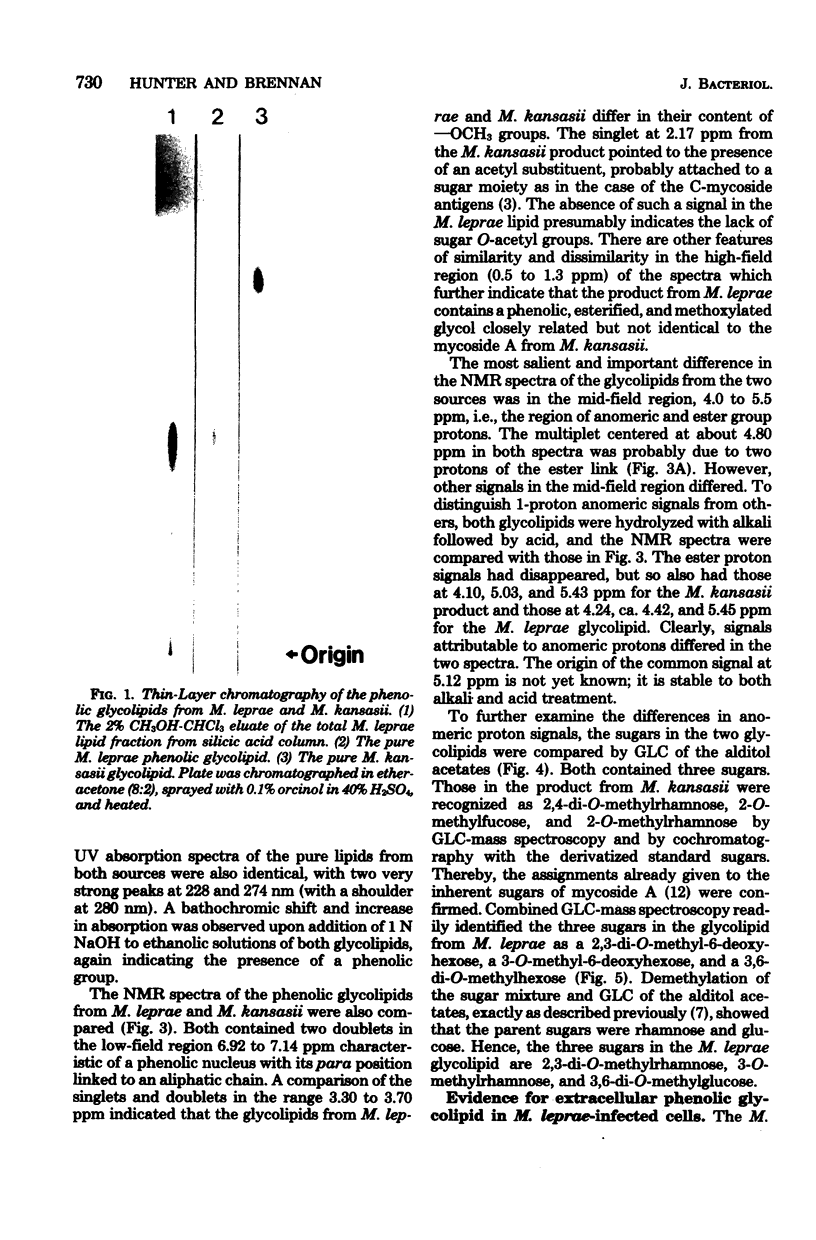
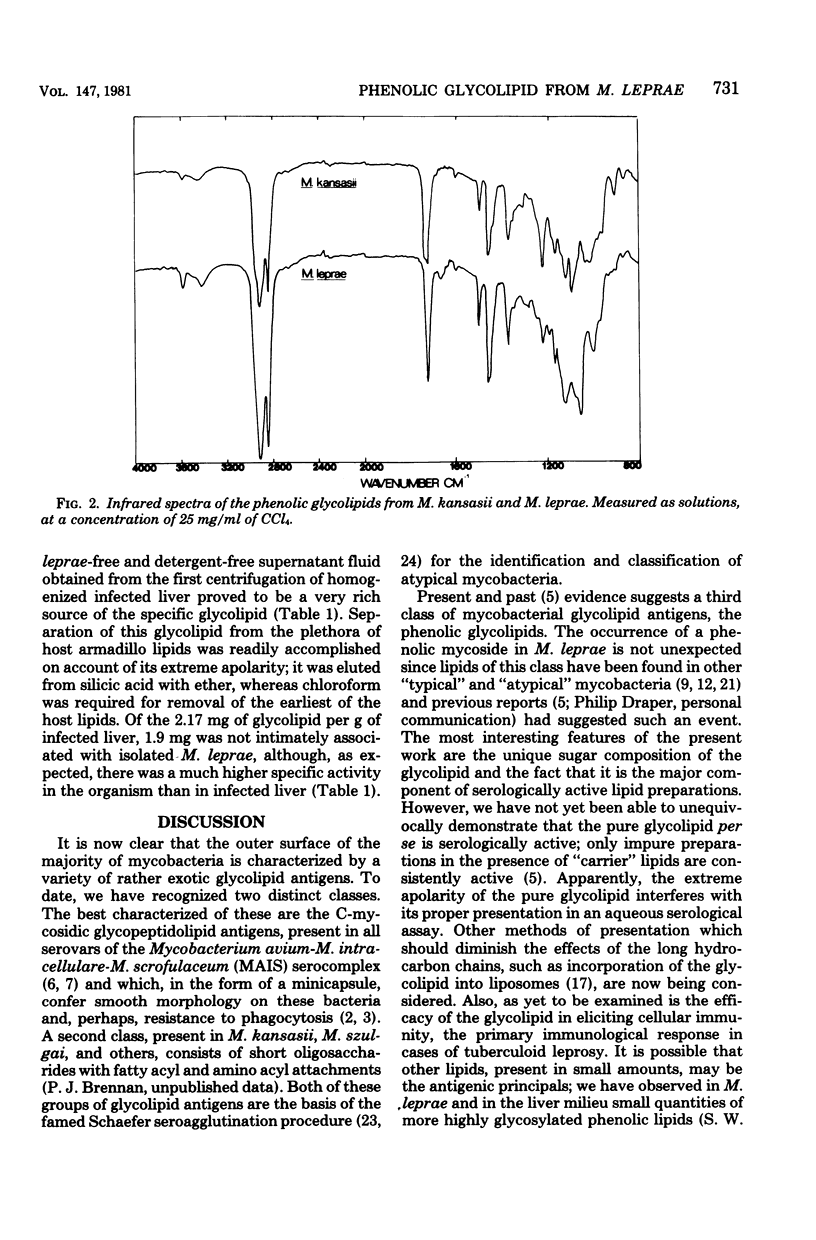
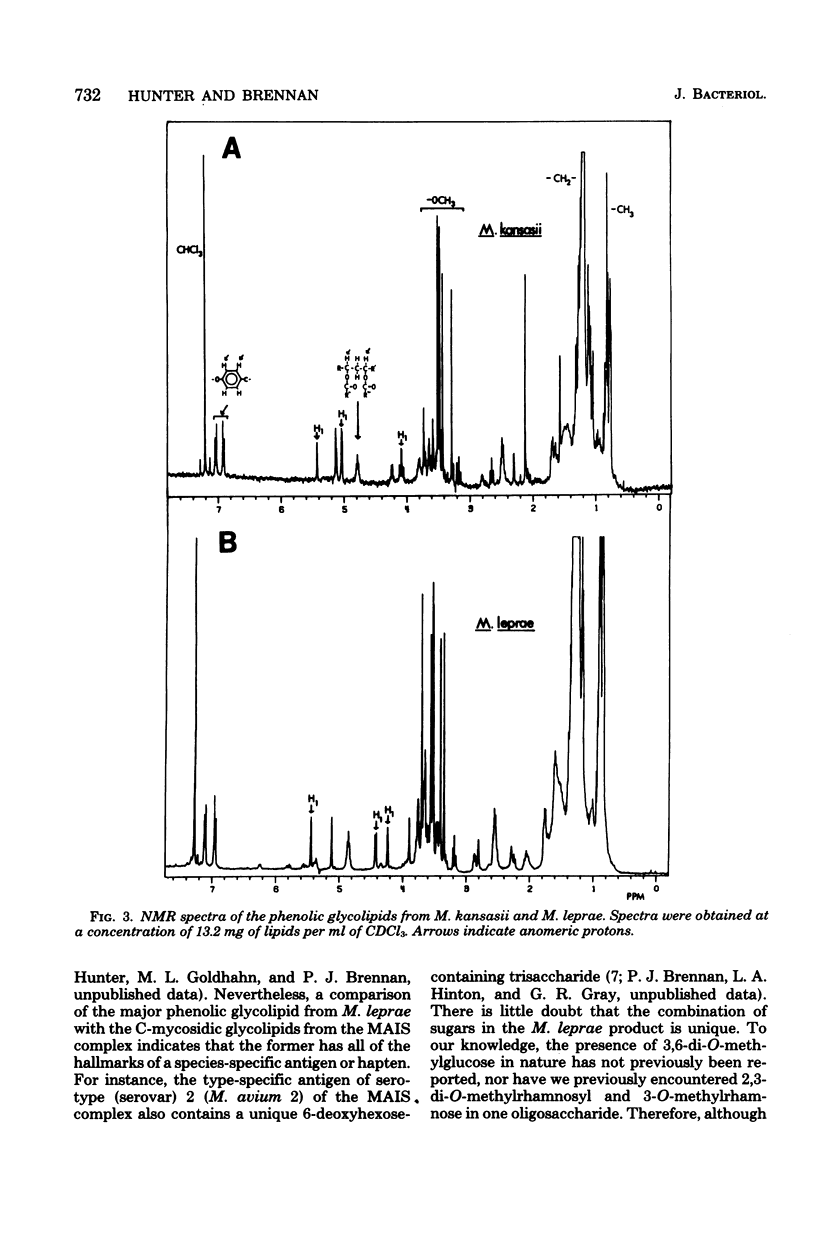
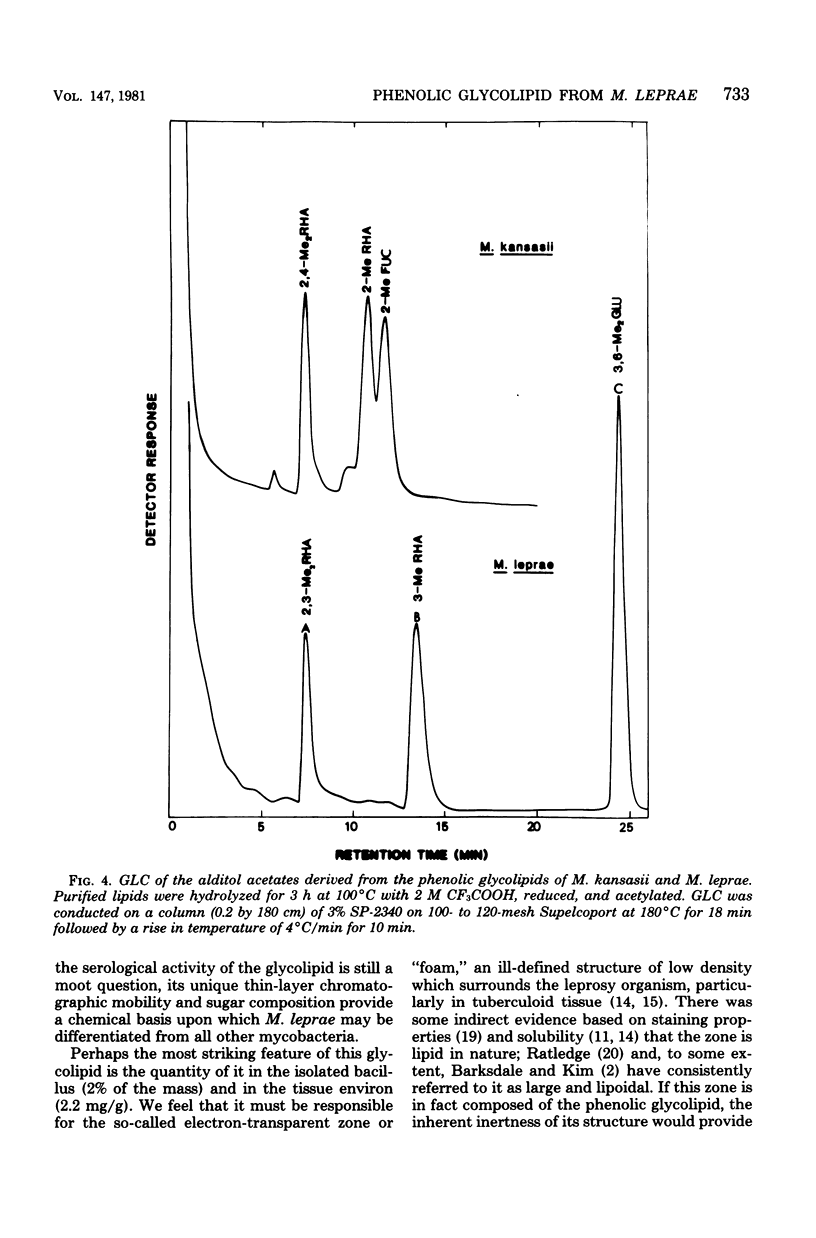
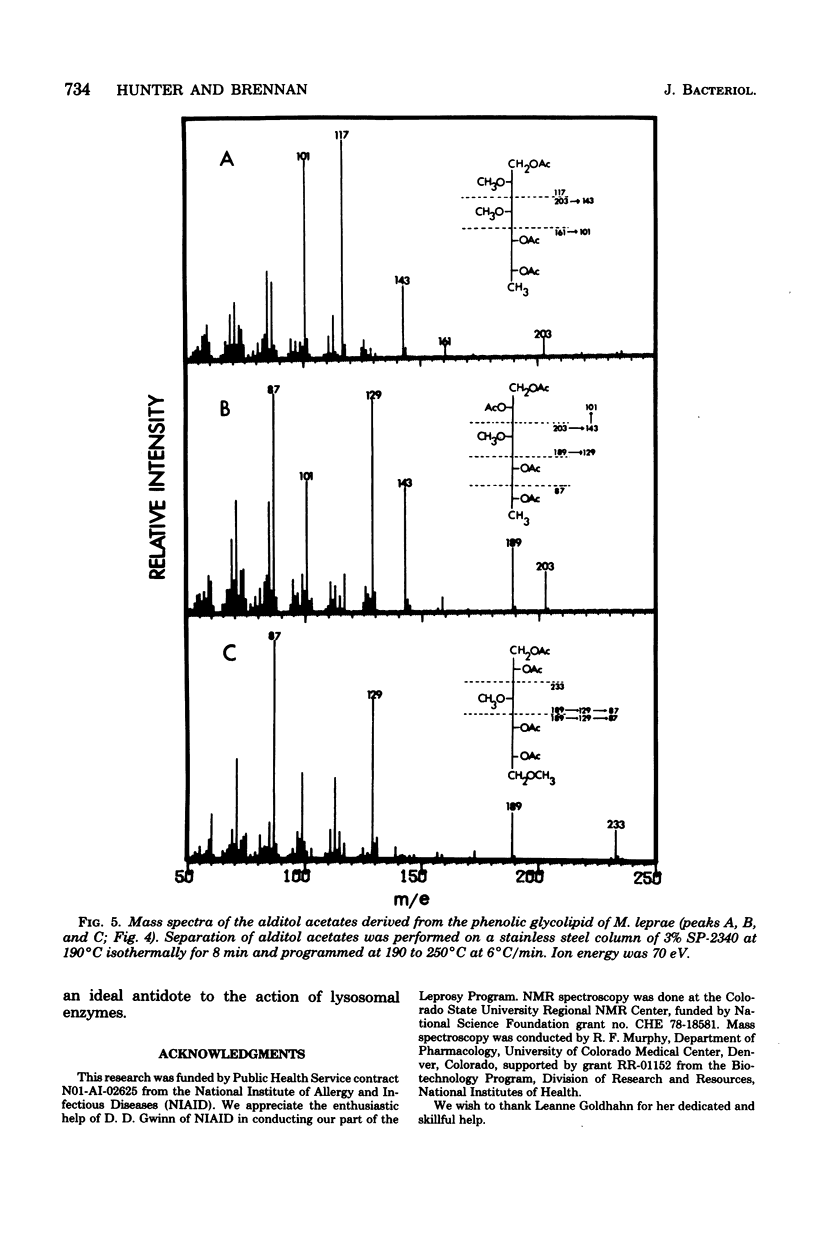
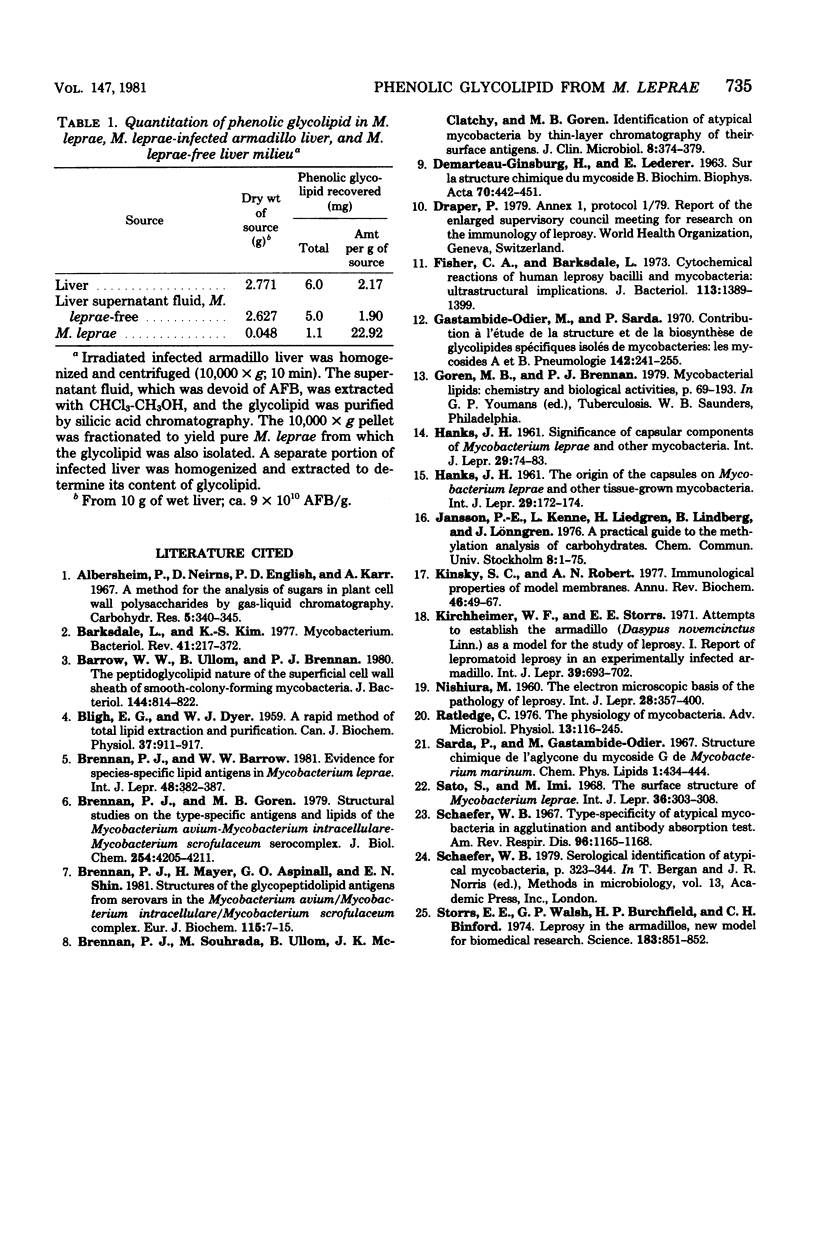
Images in this article
Selected References
These references are in PubMed. This may not be the complete list of references from this article.
- BLIGH E. G., DYER W. J. A rapid method of total lipid extraction and purification. Can J Biochem Physiol. 1959 Aug;37(8):911–917. doi: 10.1139/o59-099. [DOI] [PubMed] [Google Scholar]
- Barksdale L., Kim K. S. Mycobacterium. Bacteriol Rev. 1977 Mar;41(1):217–372. doi: 10.1128/br.41.1.217-372.1977. [DOI] [PMC free article] [PubMed] [Google Scholar]
- Barrow W. W., Ullom B. P., Brennan P. J. Peptidoglycolipid nature of the superficial cell wall sheath of smooth-colony-forming mycobacteria. J Bacteriol. 1980 Nov;144(2):814–822. doi: 10.1128/jb.144.2.814-822.1980. [DOI] [PMC free article] [PubMed] [Google Scholar]
- Brennan P. J., Barrow W. W. Evidence for species-specific lipid antigens in Mycobacterium leprae. Int J Lepr Other Mycobact Dis. 1980 Dec;48(4):382–387. [PubMed] [Google Scholar]
- Brennan P. J., Goren M. B. Structural studies on the type-specific antigens and lipids of the mycobacterium avium. Mycobacterium intracellulare. Mycobacterium scrofulaceum serocomplex. Mycobacterium intracellulare serotype 9. J Biol Chem. 1979 May 25;254(10):4205–4211. [PubMed] [Google Scholar]
- Brennan P. J., Mayer H., Aspinall G. O., Nam Shin J. E. Structures of the glycopeptidolipid antigens from serovars in the Mycobacterium avium/Mycobacterium intracellulare/Mycobacterium scrofulaceum serocomplex. Eur J Biochem. 1981 Mar 16;115(1):7–15. doi: 10.1111/j.1432-1033.1981.tb06190.x. [DOI] [PubMed] [Google Scholar]
- DEMARTEAU-GINSBURG H., LEDERER E. SUR LA STRUCTURE CHIMIQUE DU MYCOSIDE B. Biochim Biophys Acta. 1963 Aug 27;70:442–451. doi: 10.1016/0006-3002(63)90774-1. [DOI] [PubMed] [Google Scholar]
- Fisher C. A., Barksdale L. Cytochemical reactions of human leprosy bacilli and mycobacteria: ultrastructural implications. J Bacteriol. 1973 Mar;113(3):1389–1399. doi: 10.1128/jb.113.3.1389-1399.1973. [DOI] [PMC free article] [PubMed] [Google Scholar]
- Gastambide-Odier M., Sarda P. Contribution à l'étude de la structure et de la biosynthèse de glycolipides spécifiques isolés de mycobactéries: les mycosides a et b. Pneumonologie. 1970;142(2):241–255. doi: 10.1007/BF02095222. [DOI] [PubMed] [Google Scholar]
- HANKS J. H. Significance of capsular components of Mycobacterium leprae and other mycobacteria. Int J Lepr. 1961 Jan-Mar;29:74–83. [PubMed] [Google Scholar]
- Kinsky S. C., Nicolotti R. A. Immunological properties of model membranes. Annu Rev Biochem. 1977;46:49–67. doi: 10.1146/annurev.bi.46.070177.000405. [DOI] [PubMed] [Google Scholar]
- Kirchheimer W. F., Storrs E. E. Attempts to establish the armadillo (Dasypus novemcinctus Linn.) as a model for the study of leprosy. I. Report of lepromatoid leprosy in an experimentally infected armadillo. Int J Lepr Other Mycobact Dis. 1971 Jul-Sep;39(3):693–702. [PubMed] [Google Scholar]
- NISHIURA M. The electron microscopic basis of the pathology of leprosy. Int J Lepr. 1960 Oct-Dec;28:357–400. [PubMed] [Google Scholar]
- Sato S., Imi M. The surface structure of M. leprae. Int J Lepr Other Mycobact Dis. 1968 Jul-Sep;36(3):303–308. [PubMed] [Google Scholar]
- Schaefer W. B. Type-specificity of atypical mycobacteria in agglutination and antibody absorption tests. Am Rev Respir Dis. 1967 Dec;96(6):1165–1168. doi: 10.1164/arrd.1967.96.6.1165. [DOI] [PubMed] [Google Scholar]
- Storrs E. E., Walsh G. P., Burchfield H. P., Binford C. H. Leprosy in the armadillo: new model for biomedical research. Science. 1974 Mar 1;183(4127):851–852. doi: 10.1126/science.183.4127.851. [DOI] [PubMed] [Google Scholar]



